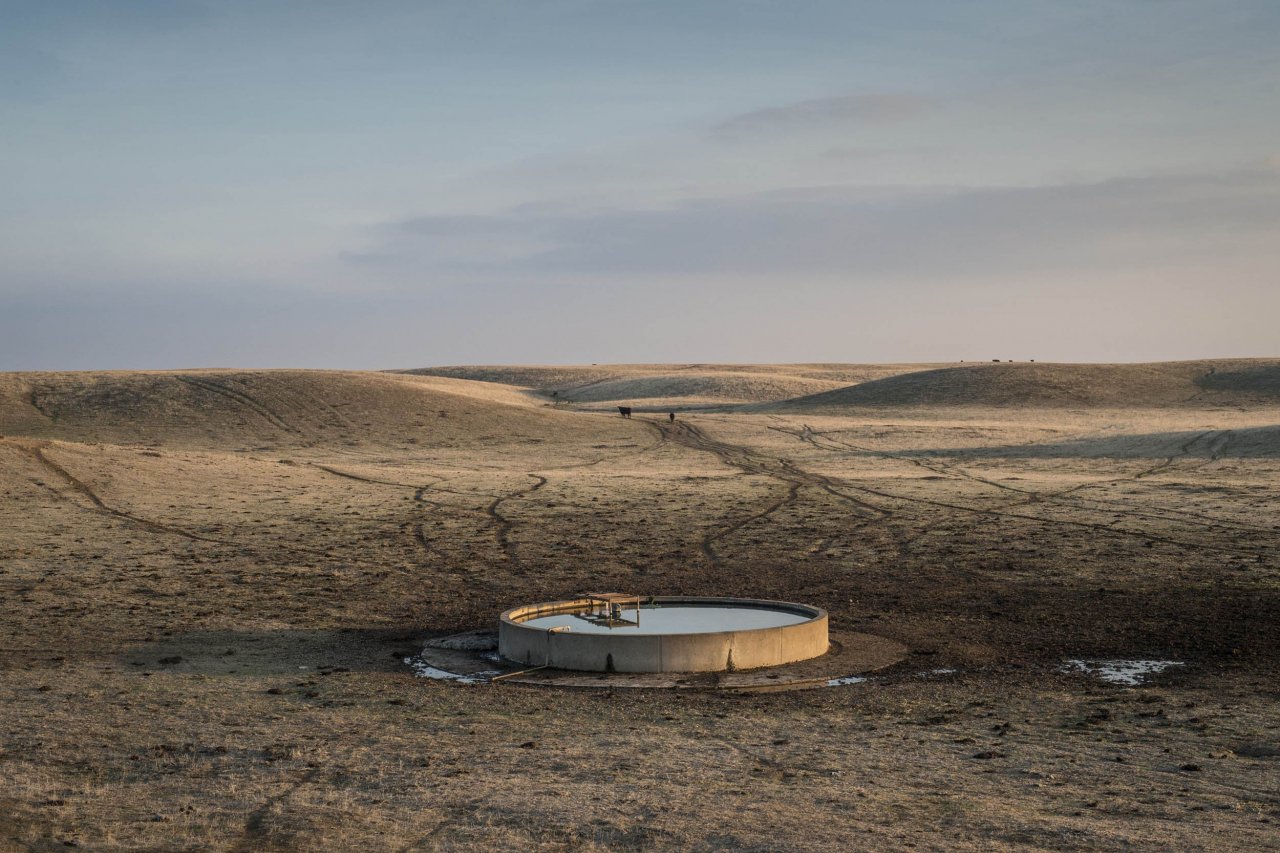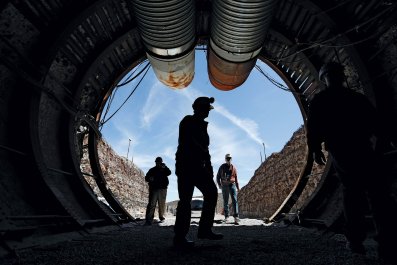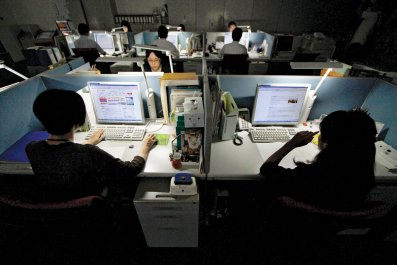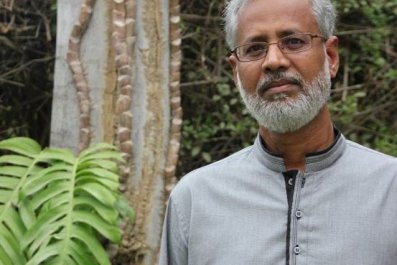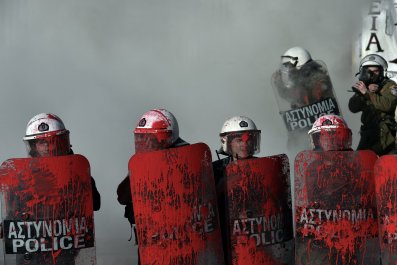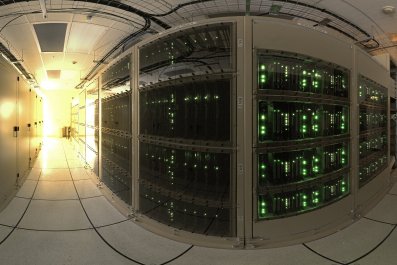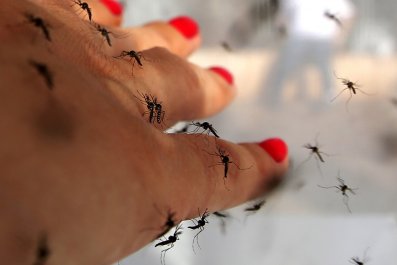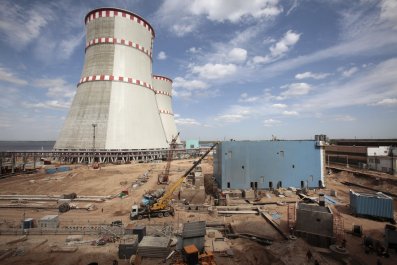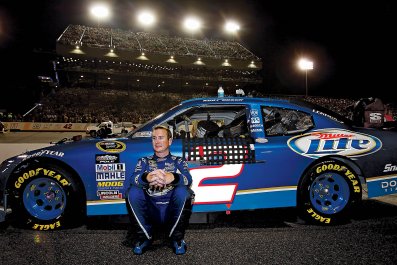Felicia Marcus, chairwoman of the State Water Control Resources Board, is trying really hard to convince me that the California dream isn't dead.
We're driving in my beat-up Volkswagen through the Central Valley, just south of Sacramento, and even here the effects of the drought are stunning: the hills to the west, usually soft and green, are burnt-crisp and yellowed. The fields spreading for miles in both directions are also toast; they look as if they would crumble under your feet. Here and there, crops still live, but they are hedged in on all sides by death.
In the past few years, a drought has been slowly strangling California. Low rainfall and record-high temperatures have created a historically devastating climate. One recent study based on tree ring data suggests that the current drought, which most consider to have started back in 2011, is the worst the area has seen in 1,200 years. Earlier this month, California's annual April Snow Survey, which measures the snowpack in the Sierra Nevada on the day of year when it is typically at its highest, found just 5 percent of the historical average. The previous low, 25 percent, was set last year.
Marcus says the good news is that no one denies reality anymore; people are ready to talk, and they think they have a solution. "It's not really a perfectly crafted plan," she admits, "but it's a promise from this administration about what we are going to prioritize over the next five years."
Governor Jerry Brown had one look at the snowpack results and took the unprecedented step of issuing an executive order that requires cities and towns throughout the state to cut back water usage by a staggering 25 percent. At an April 1 press briefing announcing the first mandatory water restrictions in California's history, he talked smack with some of his typical rough-hewn candidness: "The idea of your nice little green grass getting lots of water every day, that's going to be a thing of the past."
It took decades of work by some of the country's greatest scientists and engineers to create the infrastructure needed to feed all those lush lawns Brown verbally laid to waste; California is in many ways the world's greatest geoengineering project. But there was a fatal flaw in their system. "We had no idea how the water cycle worked" in the early 20th century, says Jay Famiglietti, senior water scientist at the NASA Jet Propulsion Laboratory. "We didn't even know what 'climate change' meant."
The ecosystem those midcentury movers of the earth created, so powerful when there is rain and snow, is entirely impotent when it stops. And now it is dangerous.
Welcome to Life on Mars
For most of the 20th century, California was as much an ideal as it was a place, sold to transplants as a true paradise—beaches, vast green lawns, eternal sunshine and the country's fertile crescent. But that was a lie. California is not lush; it's arid and dry, more Greece than Grenada. Nature certainly did not intend for there to be hundreds of thousands of acres of lawns and orange groves and almond orchards there. Nor could it ever have supported the 38 million people who now live there. The sprawling Southern California megalopolis—bleached by the sun and desiccated by its heat—is like a settlement on Mars: Everything it needs to survive is hauled in.
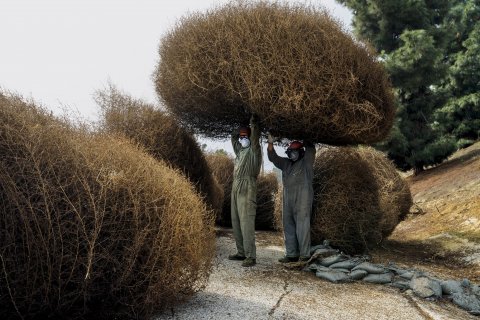
It took a unique confluence of irrigation evangelism, engineering know-how and an appetite for large public works to make California California. It started up north. San Francisco was the state's first urban hub, and as the city grew in the early 20th century, so did its thirst. In 1916, construction began on the Hetch Hetchy water system, a project to dam up its namesake valley and construct waterways to deliver water to the Bay Area. Over the next two decades, engineers built tunnels, dams, reservoirs, hydroelectric powerhouses and a 150-mile aqueduct; in 1934, the water started to move. It was one of the largest man-made water conveyances in the world, delivering about 260 million gallons per day.
A quick note about measuring water: Chances are, you think of it in terms of gallons. But counting gallons quickly becomes impossible when scaled to the levels of California's needs. The water management industry measures in million acre-feet (MAF). It takes more than 325,000 gallons to make 1 acre-foot. Hetch Hetchy, which delivered over 290,000 acre-feet per year, was big for its time, but was nothing compared with what was to follow.
The success of Hetch Hetchy begat further feats of engineering spurred on by some of the country's wealthiest businessmen (including the owners of the Pacific Fruit Express, a joint venture between the Southern Pacific and Union Pacific railroads focused on shipping produce back East) and their evangelists, who had designs on making the Central Valley—which had sun and soil, but no water—the Eden of agriculture. In the late 1930s, the Central Valley Project (CVP) put up its first dams and canals.
Today, the CVP stores about 11 MAF of water in 22 reservoirs and delivers 7.4 MAF a year to the Central Valley, irrigating more than 3 million acres of cropland. Sacramento followed suit in the 1960s, building the State Water Project (SWP), a system of 20 reservoirs that can hold 5.8 MAF, along with waterways that crisscross the state and deliver about three MAF annually to over 25 million residents and more than 750,000 acres of agricultural land. Combined, these two water conveyances traverse over 1,200 miles and are by far the two largest such projects in the U.S.
They were also largely responsible for creating what we all think of as California. The CVP helped turn the San Joaquin Valley from a high desert into the country's most important hub of agriculture (a stunning feat of hubris and engineering that the U.S. Geological Survey called "the largest human alteration of the Earth's surface"), while the SWP provides a good chunk of what makes Los Angeles and the Inland Empire livable.
"California [became] associated with producing all the food people eat. And that imagery is very much associated with the rise of Southern California in particular—this paradise where they can just grow oranges," says Robert Chester, an environmental historian at the University of California, Berkeley. "It's the foundation upon which a larger identity is then cemented...California as the land of opportunity."
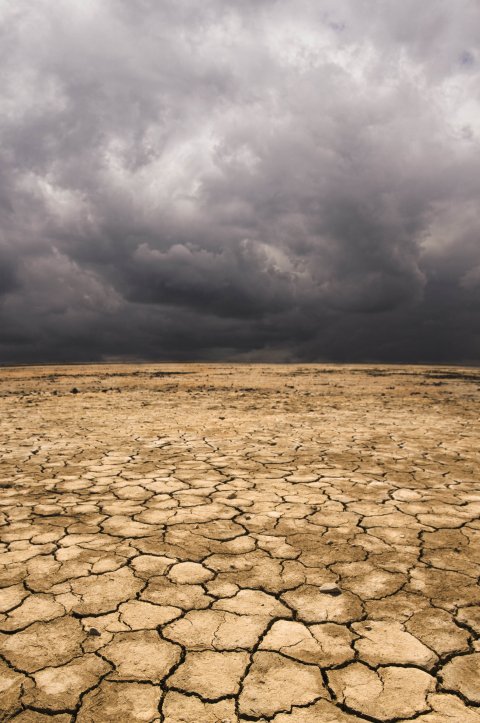
The staggering ingenuity of those hydraulic scientists and engineers seduced the state's residents into complacency; they assumed the pocket-protector geeks could always figure out new ways to shift water around. Cut back? Conserve? Not in the Golden State! That attitude still exists in many corners: There have been not entirely facetious proposals to, for example, build a massive pipeline from Alaska down to California's Shasta Lake and construct a channel to shore up the flows of the Colorado River (which feed San Diego and other cities) with waters from the Missouri River.
Water engineering created "a momentum that took on a life of its own as the panacea," says Chester. "This same mentality acts as a cultural myopia that prevented the consideration of alternative approaches that incorporate more practical and adaptive responses to limited water."
As the Stanford Woods Institute for the Environment pointed out in a 2014 paper, technological change in the water sector "has generally been marked by stagnation" since the 1970s. A striking comparison can be made with the clean energy sector: From 2000 to 2013, $69 billion was invested in clean energy, and just $1.5 billion was invested in water. In the past decade, solar panels have become increasingly efficient and electric cars close to ubiquitous. Meanwhile, we have come up with no new technologies for increasing water supply or lowering demand. On top of that, the water infrastructure is decaying. The California Urban Water Conservation Council works with 76 different urban water agencies. In 2012 (the last year for which it has data), those agencies lost an estimated 57.3 billion gallons of water.
The recent drought has made clear how obsolete California's water technology has become. The silver lining: It may also force California to invest in new science that can help save the state from itself.
Drinking From the Toilet
Take Interstate 5 south 400 miles from Sacramento and you'll end up in Orange County—so named, wrote local historian Jim Sleeper, not for any existing orange groves but instead for the promise of a paradise in which the citrus might, one day, thrive. As it did. For years, that covenant was fulfilled with waters piped in from the north. Today, in the aptly named suburb of Fountain Valley, one of the country's most innovative wastewater recycling solutions is weaning the county off those wet imports.
Everything is shiny as hell at the Groundwater Replenishment System (GWRS). The administrative building is roofed in red Spanish tile and has air conditioning to meet your body's every need and dream. There are tidy trophy cases in the hallways, and upon leaving, I am given a swag bag that includes A History of Orange County Water District, an 85-page booklet printed on 32-pound bond paper, full color. The GWRS is a prodigiously efficient network of thousands of gleaming pipes, hundreds of pneumatic valves and various other plumbing fixtures, all operating at full capacity with almost no one in sight.
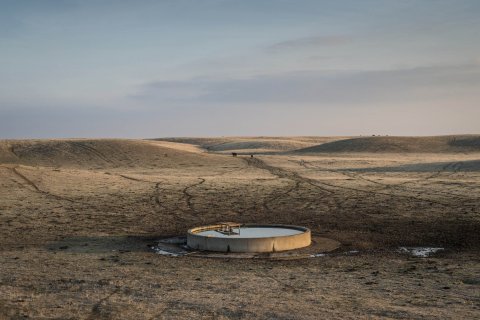
The GWRS is the world's largest indirect potable-water system, producing, on average, 215 acre-feet of drinking water a day. It's been in operation since 2008 and is such an unmitigated success that it's already expanding; by the end of May, it will be up to 307 acre-feet per day. That's enough, says General Manager Michael Markus, to provide for the daily water needs of 850,000 people—about one-third of Orange County's residents. "We looked like geniuses in 2008 because we were in the middle of a drought," he says, "and now we look like geniuses again."
The GWRS provides the county with a drought-resistant source of water, at very reasonable prices: It costs water retailers just $478 per acre-foot. That price is driven down by "subsidies" in the form of grants from an old state water bond. But if you took that out of the equation, says Markus, you are still talking just $850—very reasonable compared with the $1,000 per acre-foot it costs to import water from the Colorado River and Northern California. It also requires only half the energy of imported water.
The plumbing is daunting, but the science and water policy implications are fairly straightforward. The county's Sanitation District is required, by law, to take indoor wastewater (sinks, showers, toilets) and treat it to the point where it is clean enough to dump into the ocean. That, of course, is a massive task...and a huge waste. So instead, the treated wastewater is sent to the GWRS, which puts it through an additional three-stage purification process: physical microfiltration (to remove solids, protozoa, bacteria and viruses), reverse osmosis (forcing it through semipermeable membranes in a pressurized vessel to rid it of dissolved salts, organic chemicals, pharmaceuticals and even the smallest of viruses) and UV treatment (to disinfect the water and destroy any last, tiny organic compounds). At the end, it's been thoroughly rid of all contaminants—the GWRS tests for 7,400 compounds as required by its state permit. The end product is probably cleaner than what comes out of your tap.
The GWRS is "the best-kept secret in Orange County," says James Herberg, general manager of the county's Sanitation District. Though there are small wastewater recycling plants in California, nothing is remotely close to the scale of Orange County's project. There are plenty of reasons why, but primarily it's because there hasn't been much appetite for or investment in water-recycling technology.
But this brutal drought has spawned many hopeful mimics. Marcus, the State Water Control Resources Board's chairwoman, says the State Revolving Loan program includes $800 million in 1 percent financing for wastewater projects, and $1.5 billion worth of requests have come in. In addition, 2014 Water Bond will add $625 million in grant funding for similar projects. "Look for an explosion" in wastewater recycling in coming years, she says. Already at least 10 substantial potable-reuse projects are in development, the largest of which is planned for San Diego. Halla Razak, that city's public utilities director, says that in November, they got the green light. In 20 years, she says, one-third of San Diego's water will come from potable reuse.
The Pacific Institute, a nonprofit research institute that focuses on water issues, estimates that statewide implementation of efficient wastewater reuse could save 1.2 to 1.8 MAF every year. "To not have ocean discharge would be a fantastic step," says Melissa Meeker, the director of WaterReuse, a nongovernmental organization focused on promoting more efficient water reclamation. "That's like free water."
Salt Water in Your Wounds
There is, of course, another source of free water, tantalizingly close to the state's biggest cities and not too far from the farmlands: the Pacific Ocean. At nearly 64 million square miles, it covers about one-third of the globe's surface and makes the acres of water pumped throughout California seem puny: The National Oceanic and Atmospheric Administration estimates it contains 660 million cubic kilometers, or about 535 trillion acre-feet.
The problem, of course, is that you can't drink any of it. Seawater also kills living plants, so it's useless for agriculture. Desalinating seawater at an economically feasible cost has long been the holy grail of water security. And recent projects suggest we might be getting closer.
In the Netherlands Antilles in the Caribbean, there have been desal plants since 1928; today, Aruba has the world's third largest such plant. In the water-poor countries of the Middle East, desalination is the difference between life and death. Saudi Arabia, for example, spent $7.2 billion to build the world's largest desal plant, capable of producing about 270 million gallons of drinking water per day. In Israel, 40 percent of the country's drinking water comes from desalination, and projects in various stages of development are expected to raise that to 70 percent by 2050.
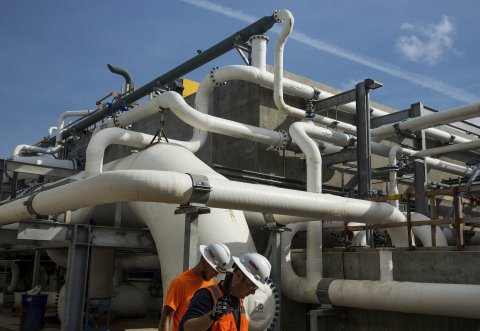
There are 2,000 desal plants in the U.S., but most are tiny, servicing the needs of a factory here and there. Every major attempt in the country has been troubled. In Florida, a plant that can produce 25 million gallons per day opened up in 2008 in the Tampa Bay area, but it took six years longer and cost $40 million more than expected to construct and rarely runs at full capacity. A plant capable of 3 million gallons per day built in tony Santa Barbara during the 1987 to 1992 drought was completed just days before torrential rains flooded California in 1993. The plant shut down and hasn't been in operation since.
But down the coast, California's first real investment in the burgeoning technology since then is on the verge of becoming operational. At the southern edge of Carlsbad, an affluent, snoozy strip of coastal suburbia north of San Diego, sits the construction yard of the $1 billion Carlsbad Desalination Project. At the gate, a Frisbee toss from the gleaming and very wet Pacific, I'm met by Peter MacLaggan, the lanky, sun-worn vice president of Poseidon Water. He tells me the plant was originally planned to open in 2016, but the drought has put it on a fast track, and it could start pumping water as early as next month.
MacLaggan has lived in water-poor San Diego his whole life. When I ask about previous droughts, he tells me what he remembers most is a lake on a friend's family's property to the east. During the drought of the late '70s, it dried up, and what remained was "so full of fish that you'd throw a rock in and the whole thing would start vibrating. There were catfish that just gave up and would jump out of the water."
The big problem now, he says, is that San Diego relies far too much on imported water; 85 percent of it comes from either the Colorado River or up north. The city has been steadily moving to reducing that reliance on outside water. Now that process will rev up. "San Diego will actually look more like it did 70 years ago, when all of our water was local," MacLaggan says. "We are going to recycle every drop we've got—and get the rest from the ocean."
One of the biggest knocks on desal is that it eats a huge amount of energy. But proponents argue that's a misguided belief based on outdated information. In the Carlsbad project—designed in consultation with IDE Technologies, an Israeli company that built and manages three of that country's desal plants—there are energy recovery units that take almost all of the latent energy that builds up in the pressurized pumps and redirects it for other uses.
MacLaggan says it works something like the regenerative braking that hybrid cars come with and calls it a "game changer." He uses this phrase a lot. "You used to need to push the water through the filtering system two times to get it drinkable; now it's just one." (Game changer.) "In the old days, the filter membranes lasted three years; now you get eight to 10." (Game changer.) "The membranes are also so much better that you need less of them." (Game changer.)

If it works, expect similar plants to mushroom up and down the Pacific coastline. At least 18 are in development already, including large projects in Huntington Beach in Orange County, Camp Pendleton (a Marine Corps base about 8 miles north of Carlsbad) and Monterey County. And in what could be read as a referendum on the technology, Santa Barbara is bringing its desal plant back online. "We have enough [water] to get us through to 2017," says Joshua Haggmark, Santa Barbara's city water manager. "But then we go over a proverbial cliff if we aren't able to bring on desal or rain." Well, you can't buy rain, but $40 million in capital plus $5.2 million in annual operating costs can buy Santa Barbara enough desal for 30 percent of the city's potable water.
Haggmark and other proponents are confident desal will become more cost-efficient, and soon. The cost has gone down considerably in the past 20 years, despite little investment in the technology. "If California would start investing in desal, you'd see a spike in investment in the technology," Haggmark says. "You'll see money managers park money there, and you'll see continuing R&D."
But many water policy experts aren't so optimistic. They point to the failures of Tampa Bay, Santa Barbara and Australia. "The Australians invested a lot in desal [facilities] during the millennium drought, and most of them are not being used at the moment" because the energy costs are still too high, says Ellen Hanak, a senior fellow at the Public Policy Institute of California and director of its Water Policy Center. She says desal makes sense only in places, such as the Middle East, where there are no cheaper alternatives.
"The cost of desal is driven by three things: the cost of land, energy and infrastructure," says Newsha Ajami, the director of urban water policy at Stanford University's Water in the West program. For desal to work economically, she says, you need to eliminate one of those costs. For example, Israel has some of the cheapest desal water, and when you go deep into the numbers, it's "because the land is basically socialized." For instance, the Ashkelon plant was constructed on land that was provided at no cost by the Israeli government. Similarly, on the Arabian Peninsula, both land and fuel are cheap and plentiful.
On the other hand, land in coastal California is notoriously expensive, and fossil fuels remain relatively costly. But there is another source of energy that California has in abundance: sun.
The Almond Tree Graveyard
I meet Garrett Rajkovich and his son Nick at a gas and fast-food way station off Interstate 5 in Fresno County. Rajkovich is a third-generation California farmer. His grandparents came from the former Yugoslavia to settle in Santa Clara County; they grew apricots and prunes there. When GE, Hewlett-Packard and other early tech companies moved in and the area turned from farms to suburbs, his father transplanted the family farming operation to the San Joaquin Valley. Today, Rajkovich farms 1,200 acres here, not too far from where the pavement hits the dirt, and where signs calling for an end to the "Congress-Created Dust Bowl" have been planted.
In recent months, Big Ag has taken a lot of heat for its role in the current water shortages. According to the State Water Control Resources Board, farms use 32.3 million acre-feet of water annually, about 40 percent of the state's total water—or 80 percent of the water used by humans (the remainder mostly flows unimpeded, a legally mandated hedge against environmental disaster)—but account for only 2 percent of the state's $2.2 trillion gross domestic product. By now everyone knows it takes a gallon of water to grow an almond, and many are using that as a rallying cry, calling on the governor to stifle agriculture's water use even further.
Without a doubt, says University of Missouri water historian Karen Piper, "we need to rethink how agriculture is done in California." There is, she says, a long history of wasteful water use in the farming sector. As soon as the CVP was developed, small farms throughout the Central Valley were encouraged to use the imported water to irrigate their crops, and they were incentivized to be liberal in their usage. "If they didn't use that water, [the U.S. Bureau of Reclamation] said it was wasting water, and they'd give it to someone else," says Piper.
Today, efficiency has improved, but not exactly in a way that helps keep water supply up. "They're growing virtually twice as much crop value as they were a decade ago precisely because they've become more efficient," says Marcus. "It's a miracle of food and fiber." But, she adds, "they haven't put in efficiency to put it back in the environment." The Pacific Institute estimates that we could save a staggering 5.6 to 6.6 MAF every year by enforcing efficiency measures—drip and smart irrigation, for example—statewide. Peter Gleick, the institute's director, is one of many water policy experts who have called for a statewide mandate requiring more efficient farming standards.
Meanwhile, farms have been forced to cut back on water use significantly. In cities, from Sacramento to San Diego, go into any business or home and try the tap. Chances are pretty good it still flows unimpeded. But many farms, including the Rajkovichs', have been running on zero water for two years now. Last year, the CVP released no water; similarly, the SWP delivered only 15 percent of its planned allocation in 2014. As a result, about 5 percent of the state's cropland was forced to go fallow, resulting in losses of over $2 billion and 17,000 jobs. This year, the CVP's tap will run dry again, and SWP deliveries will be limited to 20 percent of contracted amounts.

As in any industry, agriculture has winners and losers. The Rajkovichs' almond, cherry and grape plants, put into the ground about eight years ago, were grown with water from the CVP. Their allocation in 2014: zero. This year will be the same. And while other farmers have been able to tap into the unregulated groundwater basins beneath their land, Rajkovich has had no such luck. "We've dug several wells thousands of feet deep, and they are perfectly dry," he says.
He shows me around what is now an almond graveyard, lined neatly with dead or dying trees. "This will be the second year that it hasn't been watered, so these trees are, for all practical purposes, dead, even though they have a few green leaves on them," Rajkovich says. "There is no crop, and there's no hope for saving them." So he's come up with an alternative: Tear the orchards out (if he can book one of the companies that do it—their dance cards are full for the next year) and plant a new kind of farm.
He drives me over I-5 and across the California Aqueduct ("The lowest I've ever seen it," he says). A few miles later, we sidle up to the North Star project, a 600-acre, 60-megawatt solar farm under construction on old, fallow farmland. If you squint your eyes, the rows of photovoltaic cells mounted on their metal poles don't look that much different from his neatly lined rows of almond trees. Rajkovich marvels that the parking lot is filled with cars. First Solar, the company developing the North Star project, says that it has generated 400 construction jobs that will last through to completion this summer, and that there will be 50 permanent jobs at the site.
Meanwhile, there's no work to be had on the Rajkovich farm. "We've probably lost four or five full-time employees that are here year-round," he says, "but seasonally we're going to lose hundreds." He's already begun talks with solar developers. "It's not nearly as lucrative as a full-producing almond orchard is," says Rajkovich. "However, it's better than nothing."
It might also be the future of the Central Valley. Recent research suggests that existing infrastructure in California could support enough solar equipment to exceed the state's current energy demands by up to five times—or perhaps to supply what's needed for new, energy-intensive development like wastewater treatment and desal plants. The Carnegie Institution for Science team that came up with that calculation found that about 13.8 million acres could be developed into solar farms without affecting the environment. In the past two years, 400,000 acres of California farmland have gone fallow, and now fit the bill.
"My son," says Rajkovich, "will probably be a solar farmer versus an almond farmer. That's the future."
The Data Drought
Everyone up and down the state, from the coast to the Sierra foothills, agrees: There is no magic bullet for dealing with the water shortage, but the state might survive if it can shake off its misguided culture of abundance.
People should stop putting water-intensive landscapes in backyards and local parks, and let the ones here now die a noble death. Those man-made green carpets use about 4.165 million acre-feet of water per year—10 percent of the state's water—and provide little in the way of value. Spain, Italy, South Africa, Chile and Israel have all learned to live without ornamental lawns. Californians can too. "We have to get away from the idea that having a nice lawn is a good thing, and towards the idea that having a nice lawn is a bad thing," says Gleick. "People's preferences and behaviors do change over time; look at seat belts and smoking. We can change the way society values certain things."
Technology will play a key role in the move toward efficiency. The state needs to repair or replace its outdated and aging waterworks with the latest and greatest. It should also consider scalable ways to improve the efficiency of the system at every node. For example, Sacramento could mandate water-efficient plumbing in all new construction. "It's sexier to visit a desal plant than a low-flow toilet," says Gleick, "but we'll get a lot more water at a far lower cost by installing low-flow toilets."
California could also save a lot of water if the water decision makers weren't working blindfolded. Nearly every policy wonk I spoke with told me that the key to a water-secure future in California is better monitoring and reporting requirements. We need to, at the very least, get up to the standards that other water-poor countries have set.
"I can tell you right now the state of every major [water] storage facility in Australia, in my app on my phone," says Marcus. Contrast that with California: Sacramento has little idea how water is used in far-flung parts of the state where local water managers act in response to the local needs of their constituents, and not necessarily to their neighbors. Among the most important missing data is how much water is being diverted from surface waterways, like the California Aqueduct, and groundwater aquifers.
"If California knew what Californians know about water, management and policymaking would be much easier," write the authors of a recent Public Policy Institute of California report. For years, the state didn't have to; there was always enough water to go around, and when there wasn't, there was always that eternal California confidence that there would be rain on the way. But, as Hanak says, "we don't have the luxury anymore of getting by with slop in the system."
The goal of Jerry Brown's executive order, combined with the Water Supply and Reliability section of last year's $7.545 billion water bond and the 2014 Sustainable Groundwater Management Act, is to end this carelessness. They require improved water-use reporting throughout the state and stricter penalties for water misuse and abuse. They also create incentives for efficiency and set aside significant money for investment in water innovation.
There's no way to predict if all these sticks and carrots will help, but there is plenty of Golden State optimism that the state isn't done for yet. As we drive through Yolo County, where 90 percent of the country's canned and processed tomatoes are grown, Marcus is telling me that the current Water Resources Control Board is ready to get things done. "Some folks call us the dream team. Other folks are probably terrified of us. But the bottom line is, we're problem solvers and our driving force is to make decisions. I know perfect is the enemy of the good."
Then she points across my chest, and I turn to look out the driver's side window at what looks to be a newly planted orchard, rows of fruit trees just a foot or two high. Marcus apologizes. "Sorry, I want you to watch the road," she says, "but I didn't want you to miss the baby trees."
Correction: This version of the article was corrected to more accurately reflect the sources of California state financing for wastewater recycling projects, adding that the State Revolving Loan program includes $800 million in 1 percent financing and the 2014 Water Bond will add $625 million.



